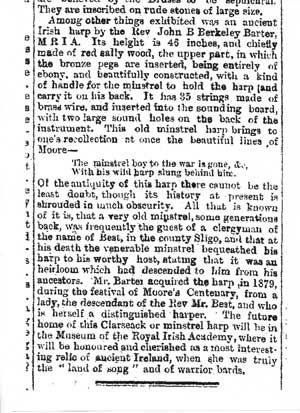
Clipping from the Freeman's Journal, 12 December 1882
| Feature | Detail |
|---|---|
| Date | The Reverend Best flourished circa 1787 [1] |
| String Count | 35 |
| Height | Approx. 117 cm |
| Soundbox | For the most part made of “Red Sally”, two access holes are in the back. |
| Current Location | See note at bottom of this page |
The edition of ‘Freeman’s Journal and Daily Commercial Advertiser’ published on 12 December 1882 included a report on the previous evening’s general meeting of the Royal Irish Academy, held at Academy House, 19 Dawson Street, Dublin. Apart from mentioning a number of the papers read, all of which were referred to the council for publication, it also gave details of some exhibits made to the meeting by members of the academy which included an ‘Irish Harp’ whose details as given in the article were as follows below.
Among other things exhibited was an ancient Irish harp by the Rev John B Berkeley Barter, M.R.I.A. Its height is 46 inches, and chiefly made of red sally wood, the upper part, in which the bronze pegs are inserted, being entirely of ebony, and beautifully constructed, with a kind of handle for the minstrel to hold the harp and carry it on his back. It has 35 strings made of brass wire, and inserted into the sounding board, with two large sound holes on the back of the instrument. This old minstrel harp brings to one’s recollection at once the beautiful lines of Moore—
The minstrel boy to the war is gone, &,
With his wild harp slung behind him.Of the antiquity of this harp there cannot be the least doubt, though its history at present is shrouded in much obscurity. All that is known of it is, that a very old minstrel, some generations back, was frequently the guest of a clergyman of the name of Best, in the county Sligo, and that at his death the venerable minstrel bequeathed his harp to his worthy host, stating that it was an heirloom which had descended to him from his ancestors. Mr. Barter acquired the harp in 1879, during the festival of Moore’s Centenary, from a lady, the descendant of the Rev Mr Best, and who is herself a distinguished harper. The future home of this Clarseack or minstrel harp will be in the Museum of the Royal Irish Academy, where it will be honoured and cherished as a most interesting relic of ancient Ireland, when she was truly the ‘land of song’ and of warrior bards.
Despite the statement made in the last paragraph regarding the harp’s future home and a similarly worded report in the Belfast News–Letter of the 13th December whose last paragraph stated that ‘The instrument was regarded with much interest by the president and other members of the Academy, and a vote of thanks was passed to the donor’, the records of the Royal Irish Academy have not revealed what may have happened to the harp subsequently.[2]
[1] In a diary entry dated 1787 the Rev. Andrew Craig records that he spent an enjoyable evening in the Rev. Best's company. Craig, Andrew. “The Journal of Andrew Craig (1754–1833).” Ulster Journal of Archeology XIV (February 1908): 13.
[2] In the Proceedings of the Royal Irish Academy Vol. 14 there are two references made to this harp. The first, on page 213, is an account of the meeting of the 11th December 1882 where it is stated that “The Rev. J. B. Berkeley Barter presented to the Academy an ancient Harp,...” and that “The Academy accorded to the Rev. Mr. Barter a special vote of thanks for his donation.” The second, on page 218, is contained in the Report of the Council for the Year 1882–83 and here amongst a list of Donations made during the same period is “an ancient Irish Harp”, which is presumably the instrument donated by the Rev. Barter. Apart from these listings no other record or mention of the harp’s possible whereabouts has yet been found.
This page was updated on 8 November, 2011 with the information contained in Footnote [2] above.
In December 2011 Reverend Best’s Harp was located and identified as being still in existence. When fuller details are obtained this entire page will be rewritten.